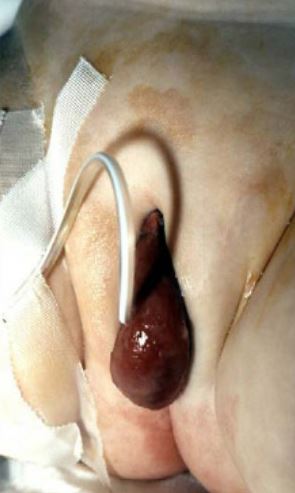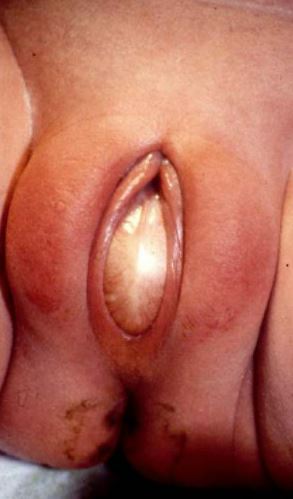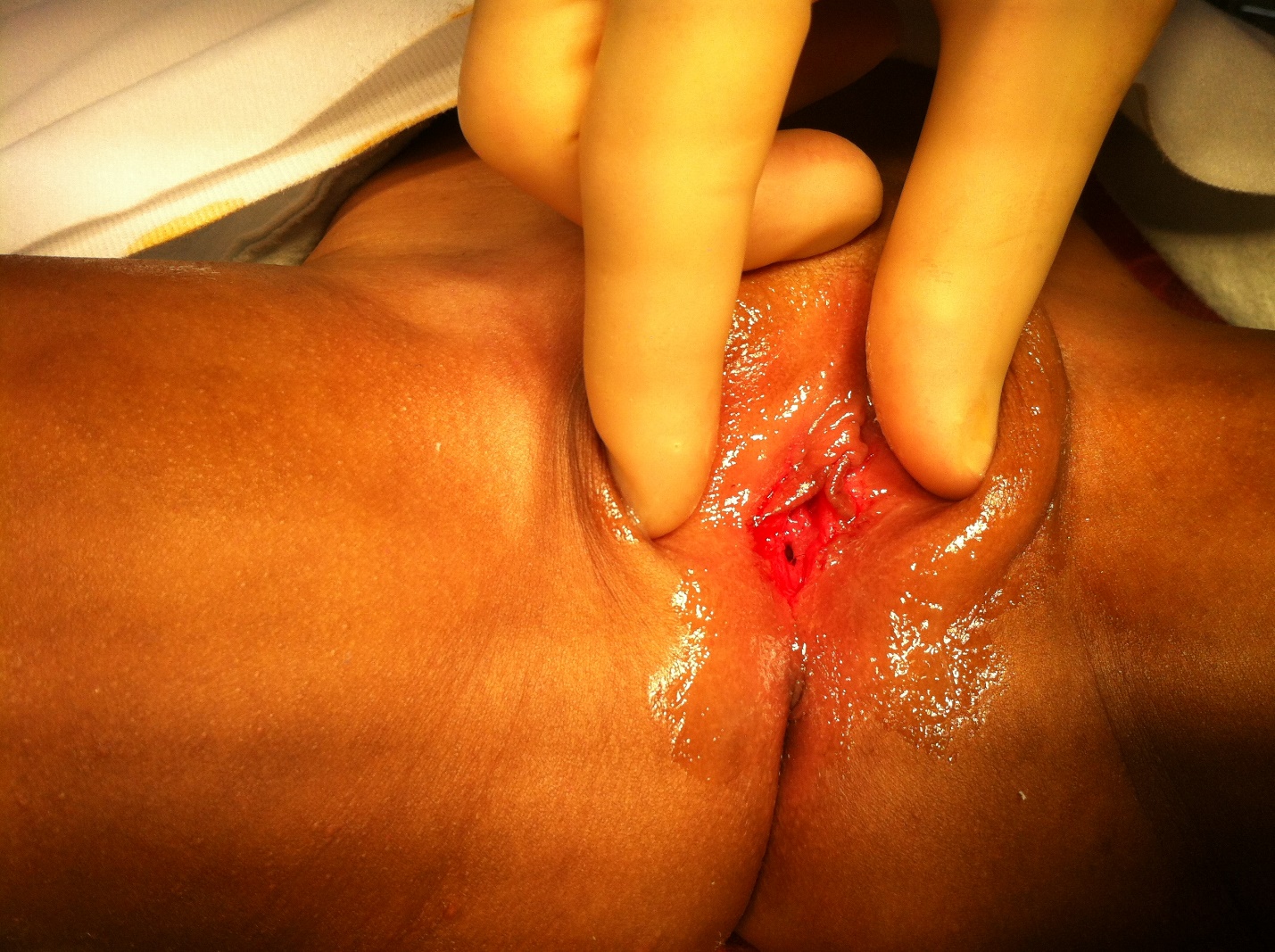36: 小儿泌尿妇科
阅读本章大约需要 3 分钟。
引言
泌尿妇科方面的主诉在任何儿科医师的临床实践中都很常见。对这些主诉的评估可能会发现多种问题,范围从良性到病理性、从行为相关到先天性不等。女孩的生殖器和泌尿系统主诉常常难以分开,有些妇科问题也需要同时评估泌尿道。本章将讨论临床医师在实践中可能遇到的一些较常见的泌尿妇科问题。
尿道旁腺囊肿
Skene腺,或尿道旁腺,是女性与男性前列腺相对应的腺体。它们起源于远端尿道的两侧,可发生阻塞而形成囊肿。尽管在成人更常见,但也可见于幼女。1 体格检查可见尿道口一侧或另一侧膨出的薄壁、张力较高的囊性肿物。需与尿道脱垂鉴别,后者表现为自尿道口环周性的膨出;也需与脱垂的输尿管囊肿鉴别,后者为自尿道腔内膨出的囊性肿物。仅凭体格检查即可作出诊断,但在需要排除泌尿道梗阻或输尿管囊肿的情况下,可行超声检查。处理通常以保守为主,因为大多数病例可自行消退。2 少见时可能需要手术切除。1,2
前庭大腺囊肿
女性的前庭大腺相当于男性的尿道球腺,双侧位于小阴唇内的4点和8点方位。3 这是一种分泌黏液的腺体,有助于阴道润滑。发生阻塞时,可能形成囊肿。再次强调,这些病变在成人更为常见,但在儿童中也可见。其发病率随年龄增长而增加,直至绝经期。4 检查可见在外阴侧壁、位于球海绵体肌深部的隆起或囊性结构。再次强调,首选处理为保守治疗。2

图 1 女童前庭大腺囊肿,囊性肿块源自左侧阴唇壁
脱垂性输尿管囊肿
输尿管囊肿是远端输尿管穿过膀胱肌壁形成的囊状膨出。许多输尿管囊肿见于重复肾集合系统。可因梗阻或膀胱输尿管返流而出现肾积水。确实,约50%的输尿管囊肿存在同侧返流,约25%合并对侧返流。因此,排尿性膀胱尿道造影是评估输尿管囊肿的关键步骤。2 随着产前超声筛查的开展,许多输尿管囊肿在围产期肾积水的评估过程中被发现。根据膨出的大小,输尿管囊肿可能经尿道脱出,尤其在女性中,可表现为自尿道腔内膨出的光滑、覆有黏膜的肿块。5 一经发现应尽快转诊治疗,治疗以手术切开和/或切除为主。6,7,8 在某些更为严重的病例中,可能需要行膀胱颈重建和/或输尿管再植术。2

图 2 伴导尿管在位的脱垂性输尿管囊肿
处女膜闭锁
在正常的新生儿发育过程中,处女膜,这是一层薄的上皮性膜,应当自发破裂。若未能如此,则形成处女膜闭锁,常见表现为青春期女孩出现闭经和周期性腹痛。9 患者也可能在新生儿期即出现临床表现,这是由于母体雌激素在新生儿体内持续循环。这会导致宫颈黏液的产生,其在阴道和子宫内的积聚可导致阴道积液(hydrocolpos)或子宫阴道积液(hydrometrocolpos)。2 临床表现可多样,包括会阴部肿物, 尿潴留,10 模拟阑尾炎的急性腹痛,11 或慢性腹痛.12 亦可观察到肾积水。13,14 体格检查时,典型发现为会阴部膨隆。处女膜切开术是根治性治疗,但临床医生还应警惕由于对膀胱出口的占位效应所致梗阻而出现尿潴留的可能,并在这种情况下置入尿道导管。2,9 临床医生也应避免仅为缓解症状而行简单抽吸或小切口,因为已有盆腔炎的报道,且复发很可能发生。5,9

图 3 处女膜闭锁伴膜膨隆
小阴唇黏连
小阴唇黏连是指小阴唇发生融合。通常起始于阴唇后联合,并以不同程度向前延伸。其发生被认为与青春前期女孩体内循环雌激素水平低有关。5 在许多女孩中,黏连无症状,但也可能表现为外阴阴道不适和刺激感、擦拭时疼痛,或排尿后滴沥;后者是由于尿液在黏连后方潴留所致。无症状的黏连可采取保守处理,因为80%会在一年内自行消退。应指导家长做好会阴卫生。2,5,15 药物治疗的基石仍为局部雌激素乳膏,且已被证实优于局部润肤剂。5,16 少数情况下,可能需要在局部或全身麻醉下进行机械分离。应告知家长复发很常见,可达15%,并应教育其在治疗成功后定期将小阴唇分开以预防复发..2,5,15 需要注意的是,家长应避免用力分开小阴唇;在涂抹局部润肤剂时轻柔加压即可防止复发,且不致造成创伤。

图 4 小阴唇黏连示例

图 5. 小阴唇黏连示例
尿道脱垂
尿道脱垂表现为自尿道外口突出的环周性隆起。该病较为罕见,原因不明地更常见于黑人女孩及绝经后女性。确切的发病率尚不清楚,因为许多患者可能几乎没有或完全没有症状而从未就医。雌激素缺乏被提出为可能的病因。这可导致远端尿道萎缩,并在腹内压升高时使远端尿道发生脱垂。尿道周围注射后也可见。暴露的尿道黏膜可发生炎症并变得脆弱,导致疼痛、排尿困难、分泌物以及出血或血尿等症状。首选的治疗为局部雌激素乳膏和坐浴。局部糖皮质激素也有应用。切除脱垂的尿道部分仅用于更为严重的病例..2,5,17 在大多数病例中,确保良好的排便习惯以尽量减少用力排便,是实现更长期疗效并避免进一步复发的关键。

图 6 幼龄女童的环周性尿道脱垂
硬化性苔藓
虽然硬化性苔藓典型地影响成人,尤其是中年女性,但也可累及幼女,其发病高峰见于4–6岁,占全部病例的7%–15%。18 起病症状包括瘙痒、外阴不适或分泌物、出血、排尿疼痛(尿痛),以及肠道和膀胱功能障碍。体检可见白色、光亮的皮肤斑块。典型构型为“8字形”,累及外阴及肛周区域。治疗采用强效外用糖皮质激素,目标除缓解症状外,还在于预防萎缩和阴道口狭窄。尽管在成人与恶性肿瘤存在一定相关性,但在儿童尚未观察到。因此在儿童中活检的作用有限。然而,长期、定期随访很重要。2,18
苗勒管发育不全
苗勒管发育缺如是指苗勒管未能发育为输卵管、子宫、宫颈及阴道上1/3,导致上述结构不同程度的缺如。最常见的临床表现为闭经。体格检查可见不同程度的阴道闭锁。鉴别诊断应包括具有46,XY核型的性发育异常,如完全性雄激素不敏感或5α-还原酶缺乏症。因此,检查应包括核型分析和盆腔超声,以评估子宫、卵巢及宫颈的有无。5 它可能与肾脏异常相关,如肾缺如,因此还应进行肾脏超声检查。一旦确诊,手术重建可包括阴道扩张、阴道成形术,甚至应用肠管构建新阴道。2
外阴阴道炎
外阴阴道炎是一个术语,用于概括外阴和阴道炎症的多种临床表现。外阴阴道炎是我们儿科女性人群中最常见的妇科主诉之一。19 其病因广泛,处理取决于潜在病因。此外,随着女孩年龄增长和生理变化,某些病因的流行情况也会改变。在幼女中,低雌激素环境导致阴道和外阴上皮薄、乳酸杆菌种类较少,从而使pH值更接近中性。进入青春期后,雌激素水平升高可促成更具保护性的环境,上皮更成熟,pH值更酸性。女性的解剖特点也很重要。阴道与肛门相距较近,可能导致粪便菌群进入阴道,尤其在年幼儿童及存在肠膀胱功能障碍的儿童中。因此,临床医师应关注排便和排尿习惯,特别注意便秘的征象。还应牢记,腹泻可能是遗粪的表现;如有任何肠或膀胱功能障碍的证据,应考虑行KUB片以评估是否存在便秘。女童其他相关的解剖和行为因素包括缺乏大阴唇脂肪垫或阴毛、小的小阴唇,以及有探索自身身体的倾向,可能将呼吸道细菌带至会阴部。20 对所有年龄段均应考虑异物、局部刺激物(如紧身内裤、沐浴皂、洗衣剂)以及特应性皮肤状况(如其他过敏或湿疹)。性虐待和性传播疾病在年长的青春期女孩中更为常见,但在所有年龄段都应纳入考虑。评估始于详尽病史,但诊断的基石是良好的体格检查。通常,将大阴唇向前向外牵拉,而非仅仅向两侧分开,可更好地观察外生殖器,包括小阴唇、尿道口和阴道口。处理策略取决于潜在病因。若怀疑酵母菌或细菌感染,或性传播感染,应给予相应的抗微生物治疗。然而,多数病例为非特异性病因,建议采取良好的卫生方法。19 应停用可能的刺激物,如紧身内裤或刺激性的肥皂。应处理肠膀胱功能障碍,通常根据需要通过口服通便方案或肠道清理来缓解便秘。
参考文献
- Foster J, Lemack G, Zimmern P. V2-06 Skene’s Gland Cyst Excision. J Urol 2016; 193 (4s): 817–820. DOI: 10.1016/j.juro.2015.02.331.
- Jeremy West AA, Cooper. Urogynecology". In: Greenfield SP, C.S., editors. Pediatric Urology for Primary Care. 2019. DOI: 10.1097/01.aog.0000231943.71829.0d.
- Omole F, K.R. P, K C, K.. Incision and Drainage of Bartholin Gland Duct Cyst or Abscess with Word Catheter Placement; Marsupialization of Bartholin Gland Duct Cyst or Abscess. Operative Dictations in Pediatric Surgery 2019; 99 (12): 217–218. DOI: 10.1007/978-3-030-24212-1_53.
- Lee WA, Wittler M. Bartholin Gland Cyst. Treasure Island, FL, USA: StatPearls Publishing; 2022, DOI: 10.53347/rid-26348.
- Wein AJ. Campbell-Walsh-Wein urology. Twelfth edition review., Philadelphia: Elsevier, Inc; 2020, DOI: 10.1055/a-1307-2419.
- Pogorelić Z, Todorić J, Budimir D, Saraga M. Laser-puncture of the ureterocele in neonatal patients significantly decreases an incidence of de novo vesico-ureteral reflux than electrosurgical incision. J Pediatr Urol 2021; 17 (4): 492.e1–492.e6. DOI: 10.1016/j.jpurol.2021.02.028.
- Nguyen DH, Brown CT. Puncture of prolapsed ureterocele at bedside without anesthesia or sedation. J Pediatr Urol 2020; 16 (3): 390–391. DOI: 10.1016/j.jpurol.2020.03.011.
- Tanneru K, Pichandi RE. A Rare Case of Prolapsed Ureterocele With Large Redundant Flap After Unroofing in Adult Female. Urology 2021; 147: 35–36. DOI: 10.1016/j.urology.2020.07.031.
- Abdelrahman HM, Feloney MP. Imperforate Hymen. Treasure Island, FL, USA: StatPearls Publishing; 2022, DOI: 10.1056/nejm191005051621806.
- Goto K. Acute urinary retention in two adolescent girls with imperforate hymen. J Obstet Gynaecol Res 2019; 45 (3): 739–742. DOI: 10.1111/jog.13875.
- Amponsah-Manu F, Ssentongo P, Arkorful T, Ofosu-Akromah R, Ssentongo AE, Hansen-Garshong S, et al.. Imperforate hymen and leaking hematosalpinx mimicking acute appendicitis: A report of a rare case and a review of literature. Int J Surg Case Rep 2019; 63: 69–74. DOI: 10.1016/j.ijscr.2019.09.003.
- Chia M, Ho C. Missed diagnosis of imperforate hymen later presenting with hypertension. BMJ Case Rep 2020; 13 (9): e237416. DOI: 10.1136/bcr-2020-237416.
- Peleg D, Shinwell ES. Newborn Imperforate Hymen Resulting in Hydronephrosis. J Pediatr 2019; 207: 258. DOI: 10.1016/j.jpeds.2018.12.051.
- Zhang M, Luo Y, Wang S, Wang S, Kuang H. A case report of hydronephrosis caused by imperforate hymen in an infant. Medicine (Baltimore) 2020; 99 (45): e23072. DOI: 10.1097/md.0000000000023072.
- Gonzalez D, Anand S, Mendez MD. Labial Adhesions. 2022. DOI: 10.1542/9781610020473-part07-ch282.
- Dowlut-McElroy T, Higgins J, Williams KB, Strickland JL. Treatment of Prepubertal Labial Adhesions: A Randomized Controlled Trial. J Pediatr Adolesc Gynecol 2019; 32 (3): 259–263. DOI: 10.1016/j.jpag.2018.10.006.
- Afolayan P, Abdel Goad EH, Pepu B. Traumatic catheterization as a precipitating factor for urethral prolapse in 4 years old child. Urol Case Rep 2020; 32: 101159. DOI: 10.1016/j.eucr.2020.101159.
- Orszulak D, Dulska A, Niziński K, Skowronek K, Bodziony J, Stojko R, et al.. Pediatric Vulvar Lichen Sclerosus–A Review of the Literature. Int J Environ Res Public Health 2021; 18 (13): 7153. DOI: 10.3390/ijerph18137153.
- Loveless M, Myint O. Vulvovaginitis- presentation of more common problems in pediatric and adolescent gynecology. Best Pract Res Clin Obstet Gynaecol 2018; 48: 14–27. DOI: 10.1016/j.bpobgyn.2017.08.014.
- Joishy M, Ashtekar CS, Jain A, Gonsalves R. Do we need to treat vulvovaginitis in prepubertal girls? Bmj 2005; 330 (7484): 186–188. DOI: 10.1136/bmj.330.7484.186.
最近更新时间: 2025-09-22 08:00